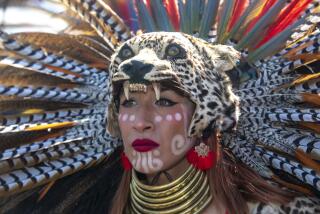30 Years Later, Kwanzaa Still Growing
- Share via
May the year’s end meet us laughing and stronger . . . may we sit again together in larger numbers. --Maulana Karenga, creator of Kwanzaa
If growth is what Maulana Karenga wished for when he thought up Kwanzaa, then he got what he wanted.
Thirty years after the seven-day African American celebration was first observed by anyone outside his Los Angeles-based organization, called US, its annual practitioners number in the millions.
The U.S. Postal Service has commissioned a Kwanzaa stamp designed by a Los Angeles artist that is to be issued next year, and companies selling everything from greeting cards to mass-produced objects used in the holiday’s rituals are trying to get a piece of the Kwanzaa market.
But on the day after Christmas, which is also the first day of Kwanzaa, Karenga stressed the holiday’s grass-roots beginnings and growth.
“We did this without legislative enactment. . . . We didn’t ask city, county, state or the federal government for money for it,” he told a cheering and ululating crowd of more than 200 people packed into his group’s African American Cultural Center in South-Central L.A.
Twenty million people of African descent now celebrate Kwanzaa--including islanders of the Caribbean, South Americans, Europeans and even Africans, said Karenga, who is chairman of the Department of Black Studies at Cal State Long Beach.
The celebrants in South-Central listened as speakers lit the candles of Kwanzaa, explaining the principles they represent, and paid homage to ancestors, from the late educator Mary McLeod Bethune to Malcolm X, with the pouring of libations and the recitations of their accomplishments.
If the gathering was an indication of who celebrates Kwanzaa, then its observers represent a diverse cross-section. There were young people who had grown up with the holiday, elderly people who didn’t know what it was until recently, scholars, community activists and educators. Many had learned the details of the observance through word of mouth and community workshops or from teachings in black studies classes.
Among them was a 23-year-old known as T-Fox, a Pan-African studies major at Cal State Northridge. He had brought his girlfriend, a cousin, and a younger brother and sister who first heard of Kwanzaa this year. T-Fox worried that Kwanzaa would be commercialized.
“I don’t like it,” he said. “Something as beautiful as this, it doesn’t need to be corrupted.”
But he was happy the holiday has gained such widespread appeal and was delighted at being able to celebrate it for the first time with Karenga.
An annual Kwanzaa parade was held Saturday in the Crenshaw district. US, in association with the Department of Water and Power’s African American Employees Assn., plans a Kwanzaa feast Tuesday downtown at the DWP building to celebrate the holiday’s three decades of existence.
Many have noted that Kwanzaa is one of the few organized phenomena sprung from the “black power” revolution era of the 1960s, of which Karenga was a part, that has not only survived, but thrived.
That is because, Karenga said, it is rooted in cultural ideals of African societies.
“Without culture,” Karenga told the gathering last week, “you don’t even know there’s a revolution going on.”
Specifically, Karenga said, Kwanzaa is intended to bring African Americans, torn from their cultural roots since the slave trade, together to celebrate their heritage and their achievements.
Most important, Karenga said, it is a time to recommit to the holiday’s principles. Those principles, all given Swahili names, are unity, self determination, collective work and responsibility, cooperative economics, purpose, creativity and faith. Karenga calls them the “hub and hinge on which Kwanzaa turns.” They should be practiced throughout the year, Karenga told his audience, and reinforced during the holiday.
The Kwanzaa ceremony is culled from several African harvest celebrations. It requires an altar with a cloth and straw mat that holds a kinara (Swahili for “candle holder”), with three red candles, three green and one black. Each candle represents a different principle. One is lit each day and its principle is discussed among participants.
Also needed are a cup, for the pouring of libations; fruit, to represent the rewards of a harvested crop; and dried corn, to represent children and the future.
Gift-giving is kept simple, preferably with handmade presents.
Kwanzaa is not intended to replace Christmas or any other holiday and can be observed by anyone of any religion, “Christians, Muslims, Hebrews and Rastas,” as one man put it. Race also is not a barrier to observance, although Karenga prefers that people of African descent conduct the rituals.
It is this secular, inclusive aspect of Kwanzaa that gives it appeal, said Val Gray Ward, a writer and performer from Syracuse, N.Y., who attended the US celebration.
“People are looking for something to hold on to,” Ward said. “A lot of black people have lost the values they had before, what they used to call Christian values--do right, make things more beautiful and help each other.”
When Karenga came up with Kawaida, the philosophy upon which the seven principles of Kwanzaa are based, she said, “it didn’t matter what religion you were,” you could embrace them and have “something to cling to.”
“If we practiced [the seven principles] every day,” Ward said, “real black power would come about.”
More to Read
Sign up for Essential California
The most important California stories and recommendations in your inbox every morning.
You may occasionally receive promotional content from the Los Angeles Times.













